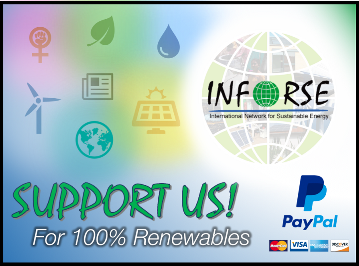|
|
|
|
|
|
|
|
|
|
|
|
|
|
|
|
|
|
|
|
|
| Follow Us: |
|
|
| Computer Tools for NGOs’ Alternative Energy Plans | |
|
What is the cheapest way to increase renewable energies for electricity? How to convince a utility that renewable energies are their future? How to ascertain that a computer planning model does not cheat renewables? By Gunnar Boye Olesen OVE, Denmark |
|
|
For NGOs working for renewable energy and a sustainable energy strategy, questions like those above will arise whenever they are involved in discussions about the future of grid-based electricity supply. It is common experience that electric utilities make their plans according to their traditional experience, and do not give fair consideration to renewable energy, energy efficiency and other local solutions. Their arguments for this are often based on results from large computer models of their electricity network and supply. Their models are not publicly available. With no access for independent reviewers or NGOs, it is not possible to check the data. Several NGOs have found it necessary to work out their own, alternative plans and models for the energy system, particularly for the electric grid. Also, a number of computer tools exist with which NGOs and independent researchers can make their alternative models and scenarios. Such tools and models have been crucial on several occasions for campaigns for sustainable energy: - A Danish model developed by three university groups was used already in 1983 to make a detailed alternative energy plan for Denmark, a plan that was supported by many Danish NGOs and in many ways inspired the official Danish sustainable energy plan “Energy 2000” launched in 1990. The model was further developed into the SESAM model that has been used by regional planners in two Danish counties as well as in the Czech Republic, Poland and Germany. - The Californian part of the Environmental Defence Fund developed the Elfin model during the 1980’s for its debates with utilities and public utility regulators. This model is now used by the Californian Pacific Gas & Electricity and other large utilities as well as by NGOs in several countries Some models (e.g. SESAM) have a detailed modelling of cogeneration and heat supply, while others (e.g. Elfin) primarily give a detailed model of the electricity supply system. |
|
| FAIRE Project | |
|
OVE, The Danish Organisation for Renewable Energy, and six other NGOs and university groups have just finished a project (the FAIRE project) in which the Elfin model was used to develop scenarios for five local supply systems in EU. Via the project, economically optimal scenarios were found with and without environmental costs for each of the areas. Most of the scenarios included increased use of renewable energy. In addition to plans for the five smaller systems, an optimisation of the French electricity supply was carried out. Even though this was done with official (low) cost figures for nuclear power plants, the economically optimal solution of most of these scenarios was to phase out the nuclear power plants within the next 20-30 years and not build new ones. The FAIRE project was supported by the EU JOULE Program. |
|
| Demanding Tools | |
|
While the benefits of independent energy plans can be large, their development is demanding, requiring data and time. The development of a model and some sustainable energy scenarios can easily require half a year’s of work or more (see box). Previously, computer power was also a limitation, but today a modern office computer can perform most optimisation. It is often advisable to start with simpler models, e.g. based on spreadsheets. They do not give economical optimisation, but they are good tools for calculating environmental and economic effects of a given investment plan. They can also be helpful for generating inputs to optimisation models. Several such models are available for NGOs, e.g.: - a simple spreadsheet used for a Danish “Energy Vision Project” 1998; - the ESM-model, a more advanced spreadsheet model with detailed sectoral breakdown, used for a Nordic energy study and in Estonia; and - the LEEP model, used for several international studies by the Stockholm Environmental Institute and others. The first two models are available from OVE / INFORSE-Europe (see below), while the LEEP model is available from the Stockholm Environmental Institute in Boston, USA (e-mail:praskin@tellus.com). |
|
| Data Needed for a Sustainable Energy Plan: | |
|
Renewable Energy Potentials: An overview is needed of the potentials for renewable energy in the area, e.g. developed with the “Guideline for Estimation of Renewable Energy Potentials, Barriers, and Effects” (INFORSE-Europe ‘97) and a wind atlas. Biomass fuel prices are also needed. Technology Catalogue: A description of each of the potential technologies is needed, including e.g. efficiency, availability, investment costs, running costs, lifetime, expected future improvements and cost reductions. Existing Supply: The existing supply (power plants, import options etc.) should be described in similar ways as the new technologies. Demand: The present and expected future energy/electricity demand is needed: total energy, peak power, load curve(s), expected future development, and expected increase of end-use efficiency. System parameters and requirements: A number of additional information is needed to describe the system, e.g. network losses and limitations of the grid, as well as, the acceptable probability that the system cannot meet demand. |
|

| |
| Published in Sustainable Energy News |
|
|
Go back to main page of ISSUE #25 (529KB) 16 pages (1999-05-01) |
|
| Contact | |
| |
INFORSE Secretariat Klosterport 4F, 1. floor DK-8000 Aarhus C Denmark Phone: +45 86 22 70 00 BlueSky: INFORSE Facebook: INFORSE LinkedIn: INFORSE Web: inforse.org E-mail: ove@inforse.org |
